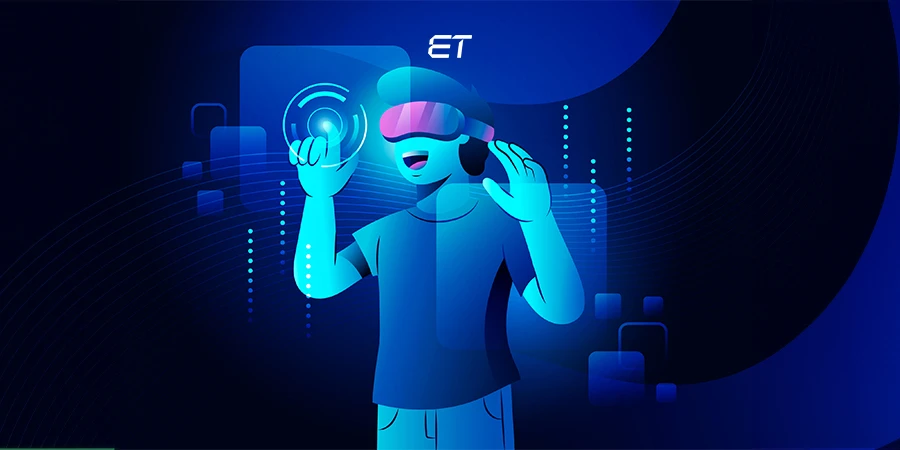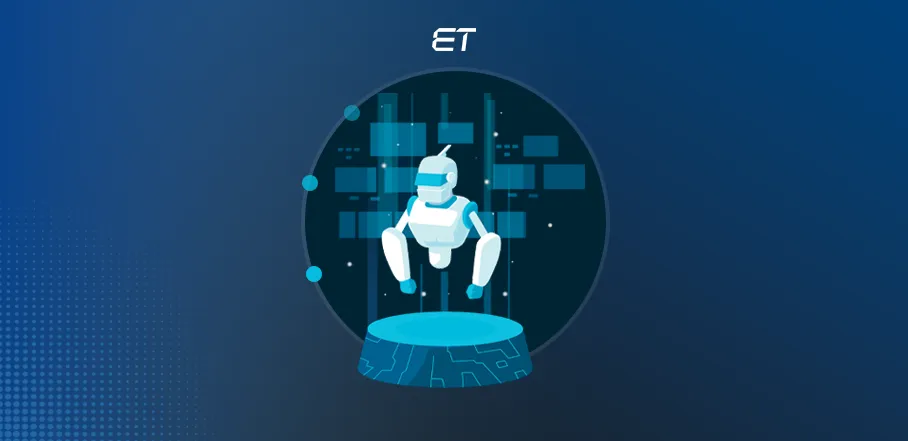
AI Copilots: Your Ultimate Tool For Enterprise Success
How easy would your life be if you had an ultra-efficient personal assistant who not only automates your routine tasks but also understands situations and problems and simplifies them for you to improve your decision-making? How sorted and streamlined!
You might not have one for your personal use, but we have one for your business use. And that is exactly what AI copilots are – a smart business assistant for your enterprise. These AI-powered tools shape your operations by automating processes and offering intelligent suggestions.
As interesting as it sounds, the potential of AI copilots is immense! These tools can significantly boost your enterprise efficiency, leaving you feeling optimistic about the future of your business. So, let’s understand AI copilot step-by-step and decipher how they can shape your business operations.
What are AI Copilots?
In simple words:
AI copilots are sophisticated software applications designed to assist users by automating tasks, providing intelligent suggestions, and enhancing decision-making processes. They leverage Natural Language Processing (NLP) and Machine Learning (ML) to effectively understand and respond to users’ input.

Want to learn about AI trends? Enterprise AI Trends to know top AI trends in 2024
How Do AI Copilots Work?
Let’s glance at how AI copilots work and how they benefit your business below.
1. Understanding User Intent
AI copilots analyze user input—whether text, voice, or code—to determine intent. They process natural language commands, queries, or prompts using NLP models, ensuring accurate comprehension of your user needs.
2. Contextual Awareness and Data Processing
Unlike basic automation tools, AI copilots continuously learn from your interactions and retrieve relevant data in real time. They pull insights from your enterprise’s systems, documents, or past user behavior to deliver context-aware responses.
3. Generating Intelligent Suggestions
Using machine learning algorithms, AI copilots predict your requirements and provide proactive recommendations. Whether suggesting optimized code snippets, summarizing reports, or forecasting trends, they enhance your software’s productivity by minimizing your employee’s manual effort.
4. Automating Repetitive Tasks
AI copilots streamline your workflows by automating repetitive tasks, such as email drafting, data entry, or scheduling meetings. They work as your digital assistants and reduce your workload while ensuring accuracy.
5. Enhancing Decision-Making with AI Models
Some AI copilots incorporate deep learning and predictive analytics to support your complex business decision-making. They analyze historical data, recognize patterns, and provide insights to help you make informed choices.
6. Continuous Learning and Adaptation
AI copilots improve over time by learning from user feedback and evolving with new data. Through reinforcement learning, they refine their accuracy, ensuring a more personalized and efficient user experience.
Types of AI Copilots
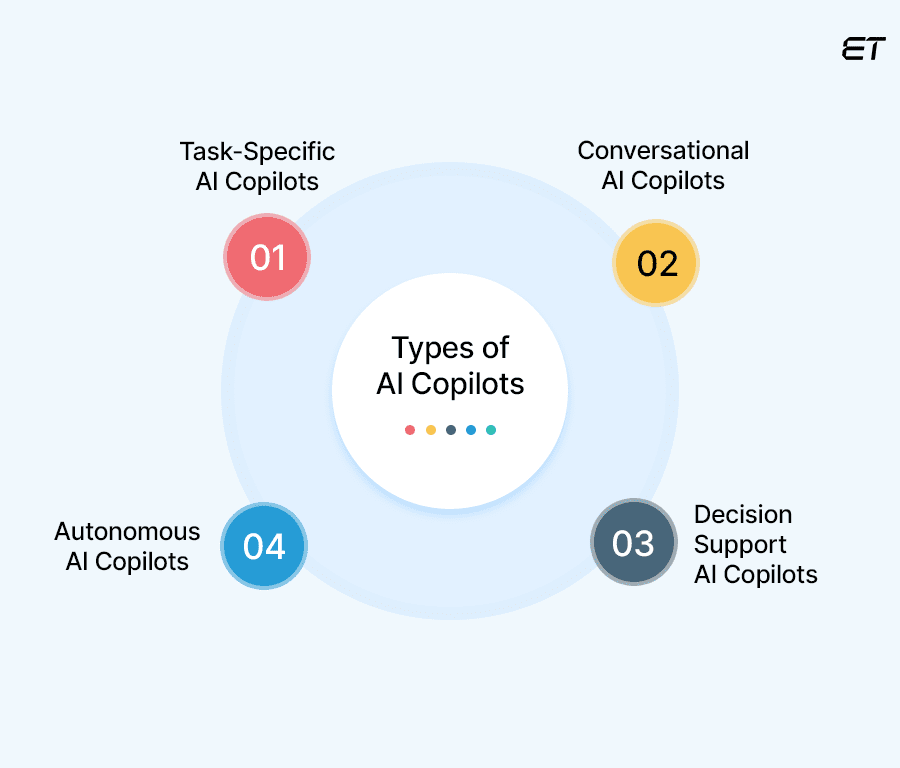
There are four types of AI copilots. Below is a brief explanation about them, along with some popular examples that you can relate to in your daily experiences and get an idea of what to expect and be able to decide which type best suits your business needs.
1. Task-Specific AI Copilots
These copilots are highly specialized, focusing on automating and optimizing specific functions within an enterprise. For example, in HR, an AI copilot can streamline the recruitment process by screening resumes, scheduling interviews, and even conducting initial candidate assessments.
Task-specific copilots are designed to perform repetitive tasks accurately and efficiently, saving time and resources.
2. Conversational AI Copilots
Conversational AI copilots leverage advanced NLP algorithms to understand and process human language. They can engage in meaningful conversations with users, providing relevant information and performing actions based on user commands.
The best and most popular example of a conversational AI copilot is OpenAI’s ChatGPT. This AI copilot can also be integrated into customer service, where it can resolve common issues, provide product information, and even assist with transactions, enhancing customer satisfaction and reducing the workload on human agents.

Can you guess what the two most popular conversational AIs are? Gemini vs ChatGPT to know about it and the head-on battle between them.
3. Decision Support AI Copilots
Decision support AI copilots analyze vast amounts of data to provide actionable insights. They use machine learning models to identify trends, predict outcomes, and recommend actions.
One of the best examples of decision-support AI copilots is GPS route planning, which assists users in determining the best possible route to reach their destinations in their daily lives. These copilots enhance decision-making processes by providing timely and accurate data-driven insights.
4. Autonomous AI Copilots
Autonomous AI copilots are designed to operate independently, managing end-to-end processes with minimal human intervention. They are ideal for tasks that require high levels of precision and consistency.
For example, code completion tools that can monitor, detect anomalies, and make real-time adjustments to optimize performance. These AI systems improve operational efficiency and reduce the likelihood of human errors.
Key Benefits of AI Copilots for Enterprises
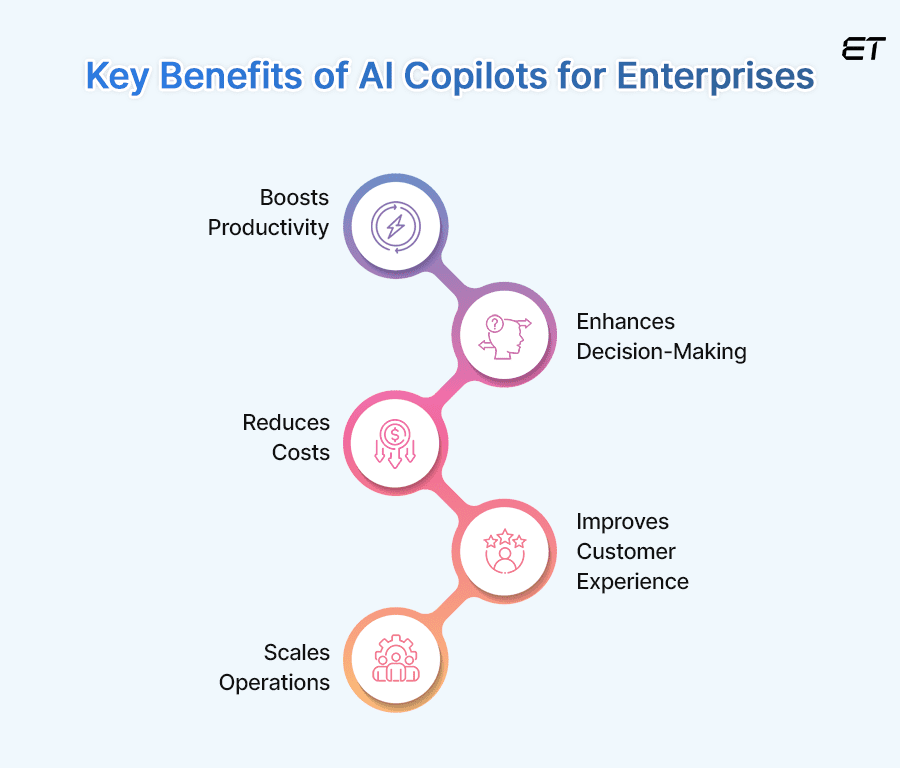
The first thing that comes to mind while talking or thinking about something is, ‘What is in there for me, and how will it benefit me?’ And that’s a good thing because it lets you see through the wall to understand what you’re getting into.
So, let’s start with understanding what your enterprise will benefit by leveraging AI copilot:
Underlined Productivity
AI copilots automate repetitive and mundane tasks, which often take up a lot of time, allowing employees to focus on more strategic activities that require human intelligence and creativity.
For example, in customer service, AI copilots can handle basic queries, freeing human agents to address and focus on more complex issues requiring their assistance. This not only speeds up response times but also improves overall efficiency.
Advanced Decision-Making
AI copilots quickly analyze large volumes of datasets and identify patterns humans might miss. Therefore, it can be said that copilots provide you with data-driven insights and recommendations, which assist you in understanding what’s suitable for your enterprise and making more informed decisions.
For example, in sales, an AI copilot can suggest the best products to purchase and upsell based on customer purchase history and behavior, thereby increasing sales efficiency and customer satisfaction.

Looking to plan your digital transformation journey strategically? Talk to our experts now!
Maximized Cost Savings
AI copilots help reduce labor costs by automating routine tasks. They work around the clock without fatigue, ensuring continuous and consistent productivity. Additionally, they minimize errors in processes like data entry and analysis, which can lead to significant cost savings.
In areas like financial services especially, this accuracy is crucial for compliance and risk management.
Enhanced Customer Experience
AI copilots can significantly improve customer experience by providing instant and accurate responses. They can handle multiple queries simultaneously, ensuring customers do not have to wait for assistance.
For example, AI chatbots in e-commerce can guide customers through their shopping journey, providing them with personalized recommendations and assistance, which in turn enhances customer satisfaction and loyalty to your brand.
Potential for Scalability
AI copilots can easily scale operations without a proportional increase in costs. As the volume of tasks increases, it can handle the additional load without hiring more employees.
This is particularly beneficial for growing businesses or those experiencing seasonal surges in demand.

It’s time to take your business to the next level in this digital transformation era. So what are you waiting for? Generative AI Models – discover all that you need to know about AI.
Limitations of AI Copilots
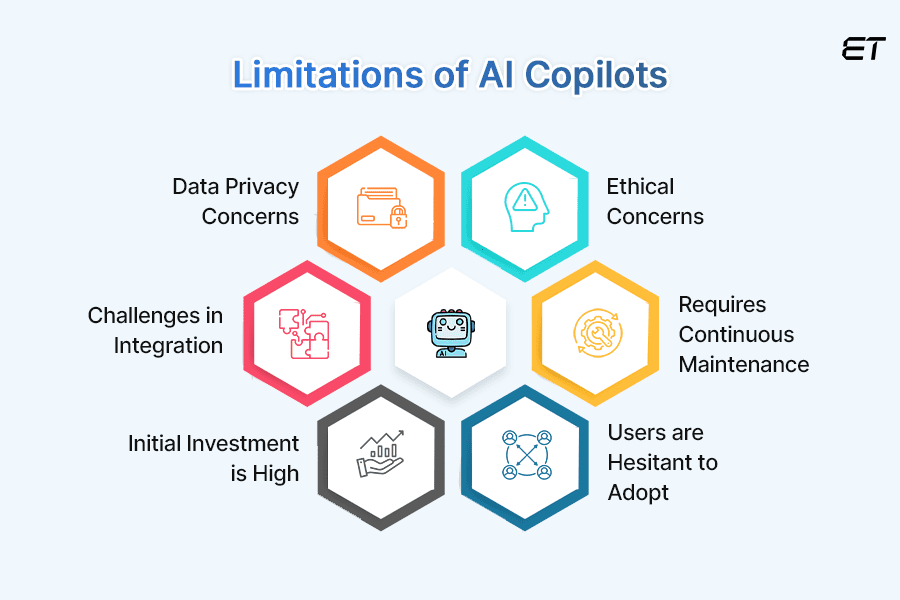
There are always two sides of the coin. Along with every pros comes the cons, so it’s better to be prepared beforehand rather than face the consequences later on.
With that said, let’s understand the challenges it poses and should be considered before moving ahead.
Data Privacy and Security
One of the primary concerns with AI copilot is the handling of sensitive data. You need to ensure that your enterprise’s data is securely stored and transmitted. Implementing strong encryption and access controls is crucial to protecting your data against breaches and complying with regulations such as GDPR and CCPA.
Integration with Existing Systems
Integrating AI copilots with your enterprise’s existing systems can be challenging. Compatibility issues, legacy systems, and data silos can hinder smooth integration. To avoid that, make sure you work with experienced developers and choose flexible AI platforms that support seamless integration.
Implementation Cost
Initially, developing and implementing AI copilots can involve significant investment, including software development, training datasets, and integration with existing systems. However, the long-term benefits and cost savings can outweigh these initial expenses.
Management Changes and User Adoption
Employees may resist adopting new technologies, especially if it comes at the cost of their jobs. Effective changes in management strategies, like training and clear communication of the benefits, are crucial for successful implementation.
However, if you ensure that AI copilots are user-friendly and complement human work rather than replace it, it will keep them assured of their jobs and ease this transition.
Continuous Maintenance and Updates
It goes without saying that technologies need continuous maintenance and timely updates to stay effective, and so does AI copilot. This includes:
- Regularly updating the AI models with new data.
- Monitoring performance.
- Addressing any issues that may arise.
Therefore, you must allocate resources for ongoing support and improvement of your AI systems.
Ethical Considerations
There are ethical concerns related to the use of AI, such as bias in decision-making and the transparency of AI algorithms. To overcome this, you must ensure that your AI copilots are fair and transparent and do not perpetuate biases in the training data.
You can mitigate these concerns by establishing ethical guidelines and regularly auditing your AI systems.

Did you hear? There is a new type of agent in the market! AI agents that reveal who it is and why it is trending.
Steps to Building an AI Copilot
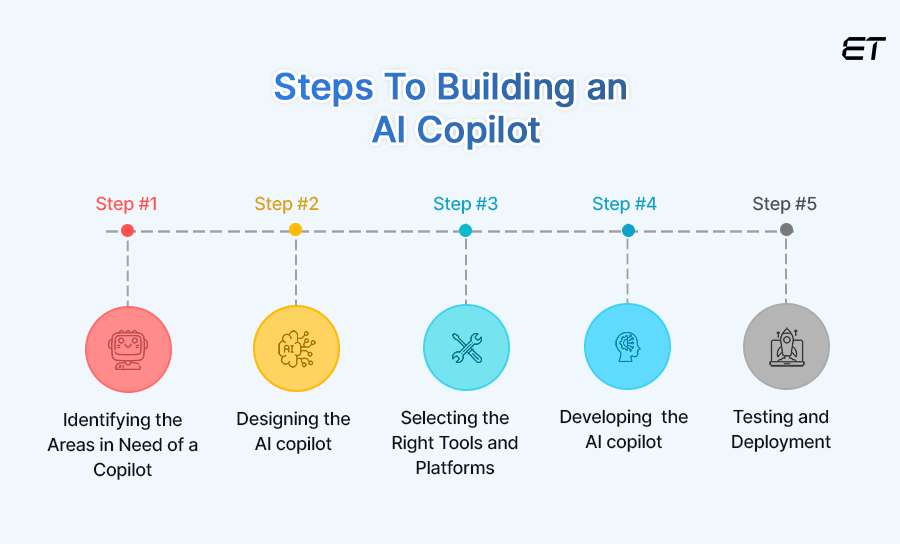
If you made it this far, then you are either a decision-maker or interested in learning more to explore AI opportunities. It’s true that AI has revolutionized and will continue to revolutionize in the coming years.
So, if you want to integrate AI copilots into your application, it’s important for you to know what are the steps involved in building it. Below is the step-by-step guide for you.
Step 1– Identifying the Areas in Need of a Copilot
Pinpoint areas where AI copilots can add significant value. You can do so by analyzing current processes and identifying repetitive tasks or areas with high data processing needs.
For example, customer service automation, sales data analysis, and HR onboarding are excellent starting points. Evaluate the potential impact and feasibility of implementing an AI copilot in these areas.
Step 2– Designing the AI copilot
After you identify and evaluate the areas with potential impact, the next step is that you need to set clear objectives and define the user experience. Factors you need to consider while designing the copilot are:
- Setting clear objectives: Define what you aim to achieve with the AI copilot. This could be reducing customer service response times, improving sales forecasting accuracy, or enhancing data analysis capabilities.
- User Interface (UI): UI is all about accessibility—how easy or complex it is for a user to operate it. So, it is important that you focus on creating an intuitive interface that allows easy interaction with AI. This includes designing user-friendly dashboards, chat interfaces, and voice command functionalities.
- User Experience (UX)— Use UX best practices to make the copilot’s responses helpful and contextually relevant to ensure smooth and efficient interactions for the users.
Step 3– Selecting the Right Tools and Platforms
This step requires you to choose the appropriate tools and platforms based on your specific needs. Some popular options for you include:
- Microsoft Copilot Studio: It offers a resilient environment for developing and integrating AI copilots with various Microsoft services.
- AWS AI Services: It provides you with comprehensive tools for building machine learning models and integrating them with AWS infrastructure.
- GitHub Copilot: This tool is useful for developers looking for code suggestions and automated programming assistance. When selecting tools, consider factors like platform compatibility, scalability, and support services.
Step 4– Developing the AI copilot
Now comes the development part of the copilot, which involves several technical steps:
- Data collection: This involves gathering and preprocessing the data needed for training the AI model. Therefore, ensure that the data is clean, relevant, and, most importantly, representative of the scenarios the AI will encounter.
- Model training: To train the AI model, you can use machine learning frameworks like TensorFlow, PyTorch, or Scikit-learn. Apply techniques such as supervised, reinforcement, or deep learning depending on the area in which you want to implement copilot.
- Validation: To validate the model’s performance, use test datasets to ensure accuracy and reliability. This involves metrics like precision, recall, F1 score, and others relevant to your application.
- Integration: After you’ve validated the model’s performance, it’s time to integrate the AI copilot seamlessly into the existing systems. Ensure that it can access necessary data and operate within your enterprise’s current IT infrastructure.
Step 5– Testing and Deployment
Before you fully deploy the AI copilot, ensure that it is thoroughly tested and has no errors.
This stage includes the following aspects:
- Unit testing: It involves testing individual components of the AI copilot to ensure they function correctly.
- Integration testing: Check for the workflows and other systems to verify that the AI copilot is integrated correctly into it.
- User Acceptance Testing (UAT): This is where you have to allow end-users to test your AI copilot in real-world scenarios and provide feedback.
- Deployment: The final stage. Once testing is complete, deploy the AI copilot in stages to avoid any complexity, starting with a pilot phase to identify and fix any issues.
Great job! Now, you need to monitor performance continuously and make necessary adjustments when and where required.
Wrapping Up!
AI copilots are revolutionizing enterprises’ efficiency. Compared to the vague picture you had before reading this blog of having business assistance, now you can picture how sorted and streamlined your enterprise will become after having one. From automating tasks and providing smart insights to enhanced decision-making, AI copilot assists your business in all possible ways.
Want to learn more about how you can increase your enterprise efficiency and which AI copilot best suits your business? Contact our experts now to plan your successful business journey to AI.

Want expert views on AI copilot for your business? Schedule an appointment today!
Frequently Asked Questions
1. What is a Copilot in AI?
AI Copilot is a smart virtual assistant that helps you complete tasks more efficiently, such as writing code, drafting emails, or analyzing data, by providing intelligent, real-time suggestions.
2. Which AI Copilot is best?
The best AI Copilot depends on your needs. GitHub Copilot is great for developers, Microsoft Copilot works well with Office tools, and ChatGPT offers versatile, all-around assistance.
3. How can I access Copilot AI?
You can access AI Copilot through platforms like GitHub, Microsoft 365, or Google Workspace by subscribing to their premium plans or add-ons that include AI features.
4. Is Copilot AI better than ChatGPT?
AI Copilot is better suited for specific tasks, such as coding or working in Office apps, while ChatGPT is a more versatile tool, excelling in general conversations and creative tasks.
5. How do AI copilots enhance customer experience?
AI copilots improve customer experience by providing instant, accurate responses, handling multiple queries simultaneously, and offering personalized recommendations, which enhance satisfaction and loyalty.
6. Can AI copilots be customized for specific enterprise needs?
Yes, AI copilots can be tailored to specific enterprise requirements by setting clear objectives, designing intuitive user interfaces, and integrating them seamlessly with existing systems and workflows.
7. What is the difference between an AI copilot and a chatbot?
An AI copilot assists you with complex tasks, automates your workflows, and enhances your decision-making, while a chatbot focuses on answering your users queries through scripted or AI-driven conversations.
Copilots are proactive and intelligent, whereas chatbots are reactive and limited to interactions they’ve been fed.



